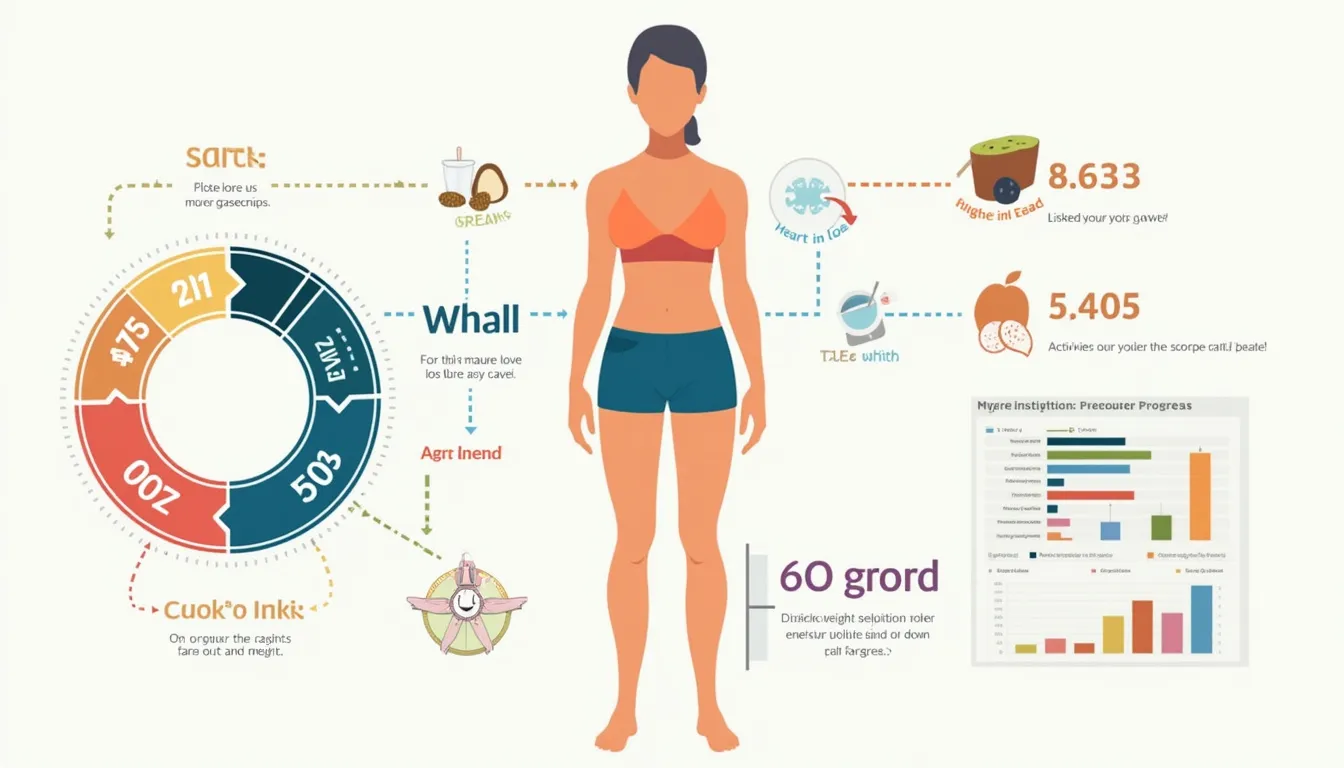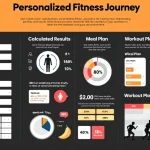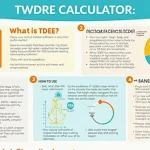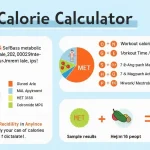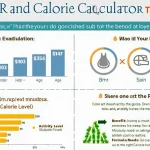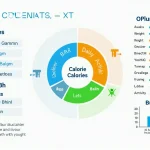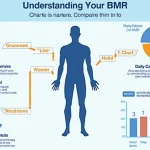Is this tool helpful?
How to use the tool
- Fill your details. Example 1: Age 29, Female, 5 ft 6 in, 158 lb, Moderately active, lose 12 lb, 14 weeks. Example 2: Age 52, Male, 172 cm, 78 kg, Sedentary, lose 6 kg, timeframe blank.
- Press “Calculate”. The tool returns BMI, BMR, TDEE, suggested calories, macros, and a weekly-weight chart.
- Apply the numbers. Plan meals around the calorie and macro targets; review progress each week.
Key formulas
- BMI $$ rac{\text{weight (kg)}}{(\text{height (m)})^{2}}$$
- Mifflin-St Jeor BMR Male: $$10w+6.25h-5a+5$$ Female: $$10w+6.25h-5a-161$$ where w=kg, h=cm, a=years.
- TDEE $$\text{BMR}\times\text{Activity Factor}$$
- Daily calories for goal $$\text{TDEE}- rac{\text{Goal Loss (kg)}\times7700}{\text{Days}}$$
- Macros 30 % protein, 40 % carbs, 30 % fat → Protein g = $$ rac{0.30\times\text{Calories}}{4}$$ Carbs g = $$ rac{0.40\times\text{Calories}}{4}$$ Fat g = $$ rac{0.30\times\text{Calories}}{9}$$
Worked example
Input. Male, 35 y, 85 kg, 178 cm, lightly active (1.375), lose 7 kg in 12 weeks.
- BMR = 10×85 + 6.25×178 − 5×35 + 5 = 1,792 kcal
- TDEE = 1,792 × 1.375 = 2,467 kcal
- Deficit needed = 7×7,700 ÷ 84 = 642 kcal/day
- Daily target = 2,467 − 642 = 1,825 kcal
- Macros ≈ 137 g protein, 182 g carbs, 61 g fat
Quick-Facts
- Safe loss rate: 0.5-1 kg week⁻¹ (CDC, 2023).
- 7,700 kcal ≈ 1 kg of body fat (Hall et al., 2008).
- Activity factors range 1.2-1.9 (FAO/WHO/UNU, 2004).
- AMDR: 45-65 % carbs, 10-35 % protein, 20-35 % fat (US Dietary Guidelines 2020-25).
- Mifflin-St Jeor predicts resting energy within 10 % for most adults (Frankenfield, 2005).
What is BMI?
BMI compares your weight to height and flags underweight (<18.5), normal (18.5-24.9), overweight (25-29.9) or obesity (≥30) classes (WHO, 2022).
How does the calculator estimate daily calories?
It multiplies Mifflin-St Jeor BMR by an activity factor—1.2 (sedentary) to 1.9 (extra active)—to yield TDEE (FAO/WHO/UNU, 2004).
What deficit should you aim for?
Create a 500-750 kcal daily deficit to lose 0.5-1 kg weekly without compromising nutrition (ACE, 2022).
What is a healthy rate of weight loss?
Losing 0.5-1 kg per week maximizes fat reduction while preserving lean mass (CDC, 2023).
How should you split macros?
Use 1.4-2.0 g protein kg⁻¹ day⁻¹ for muscle retention (Phillips, 2016) and balance remaining calories 40 % carbs, 30 % fat.
Can you enter pounds and inches?
Yes—choose “lbs” and “ft / in”. The tool converts to metric internally (1 lb = 0.4536 kg; 1 in = 2.54 cm) (NIST, 2019).
Why does activity level matter?
Higher activity boosts daily energy burn, so calorie targets rise accordingly to maintain the same deficit (FAO/WHO/UNU, 2004).
What if weight loss stalls?
Re-measure intake, increase activity, or reduce calories by an extra 100-200 kcal; metabolic adaptation can lower TDEE by 5-15 % (Rosenbaum, 2018).
Important Disclaimer
The calculations, results, and content provided by our tools are not guaranteed to be accurate, complete, or reliable. Users are responsible for verifying and interpreting the results. Our content and tools may contain errors, biases, or inconsistencies. Do not enter personal data, sensitive information, or personally identifiable information in our web forms or tools. Such data entry violates our terms of service and may result in unauthorized disclosure to third parties. We reserve the right to save inputs and outputs from our tools for the purposes of error debugging, bias identification, and performance improvement. External companies providing AI models used in our tools may also save and process data in accordance with their own policies. By using our tools, you consent to this data collection and processing. We reserve the right to limit the usage of our tools based on current usability factors.
